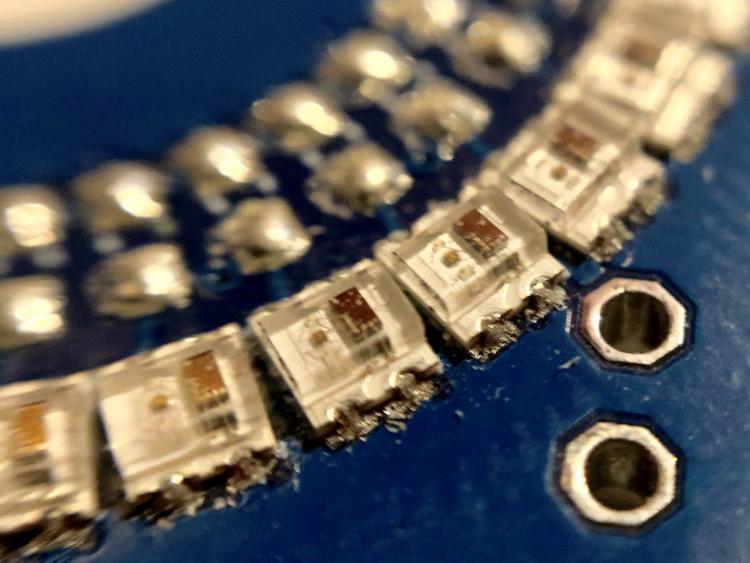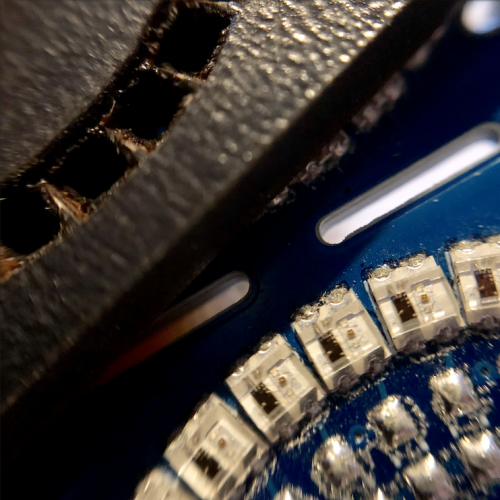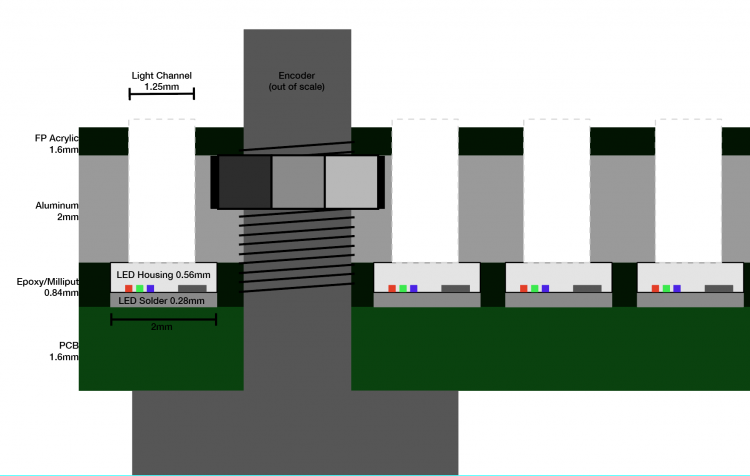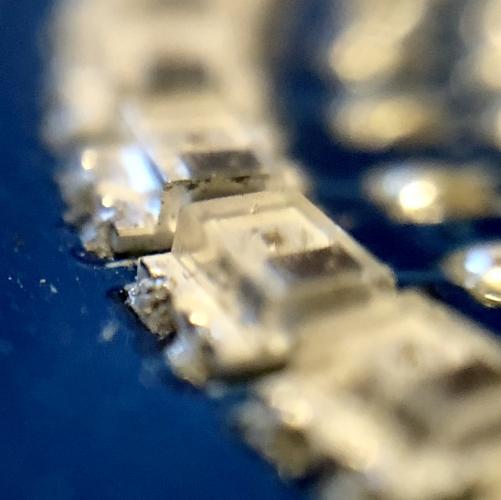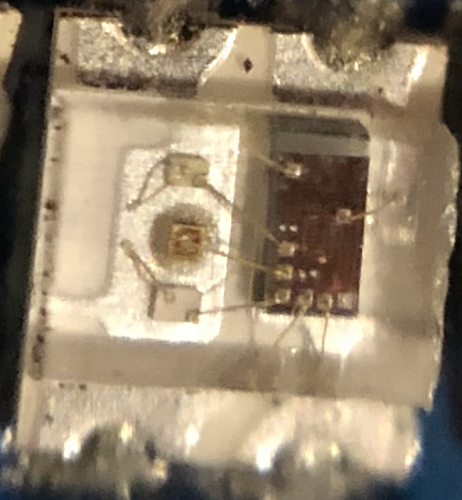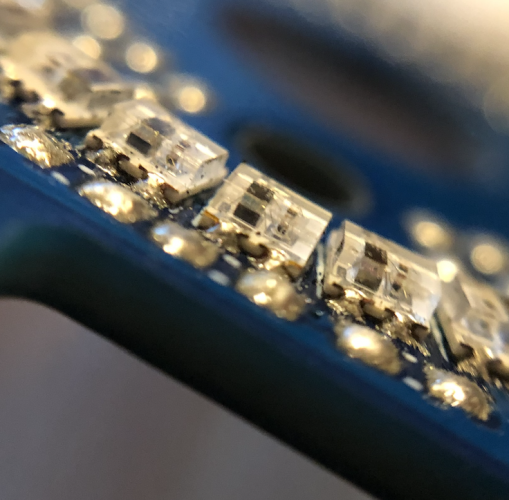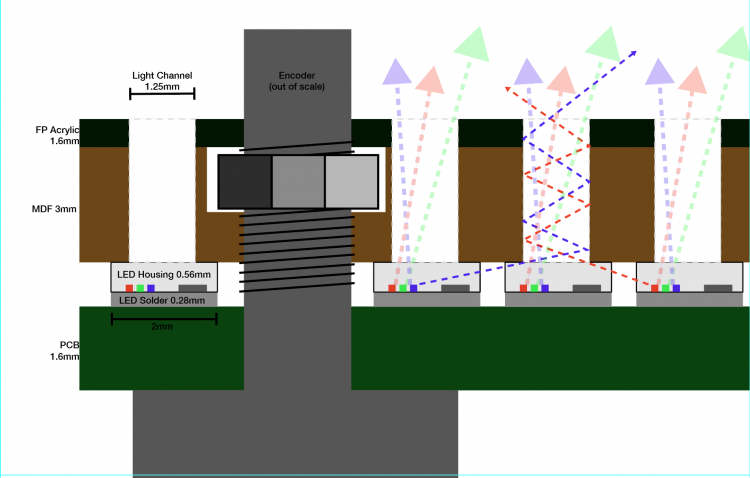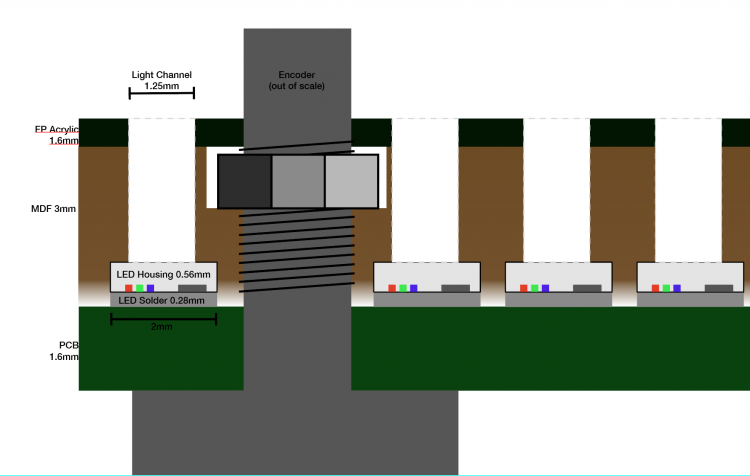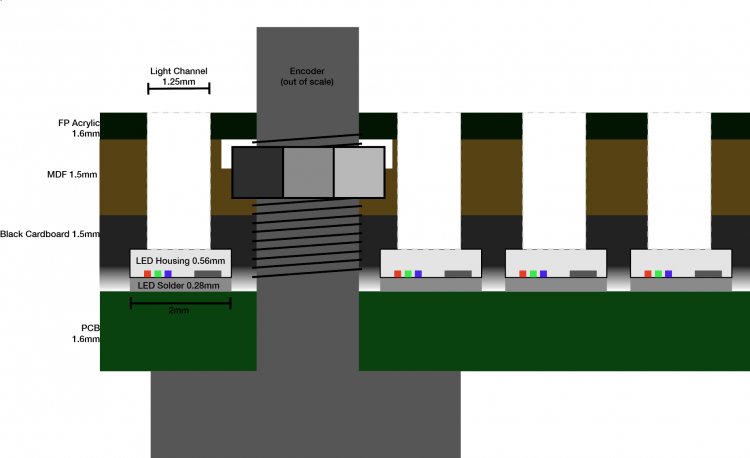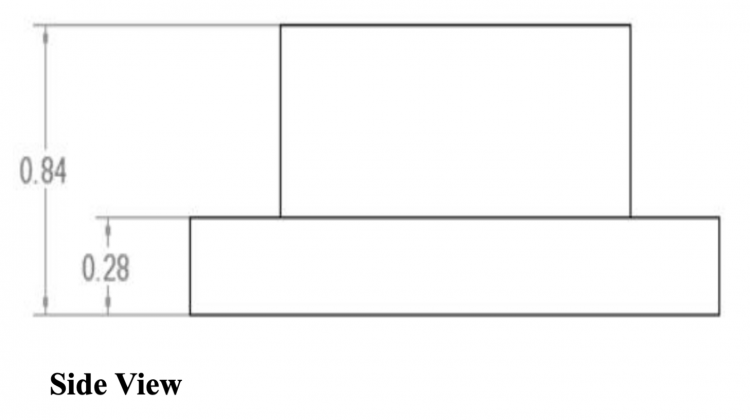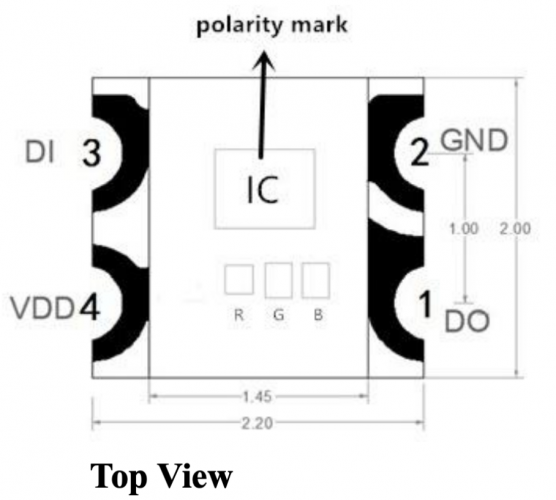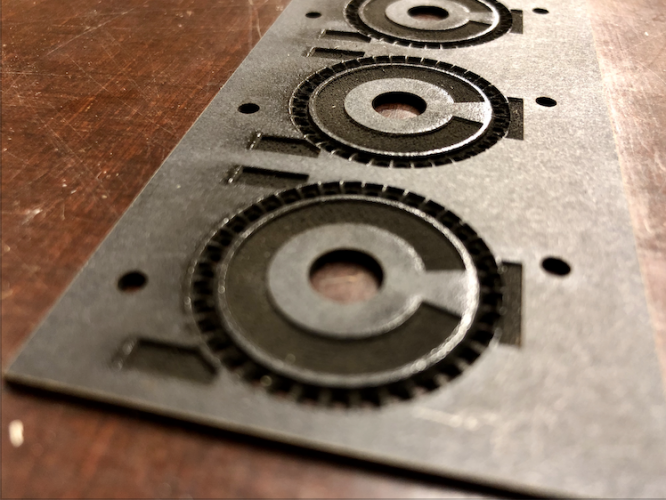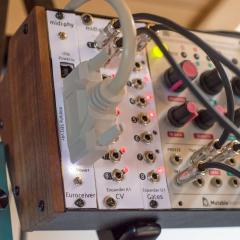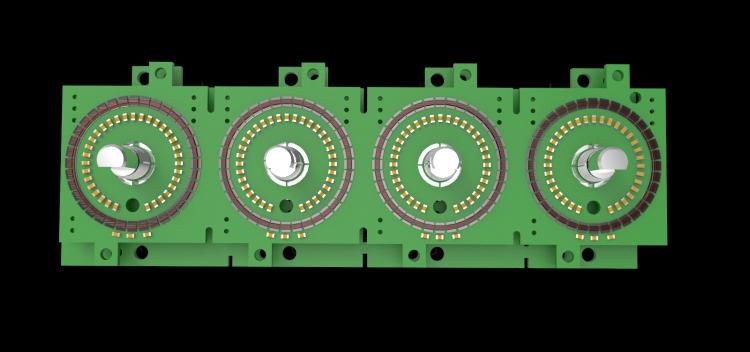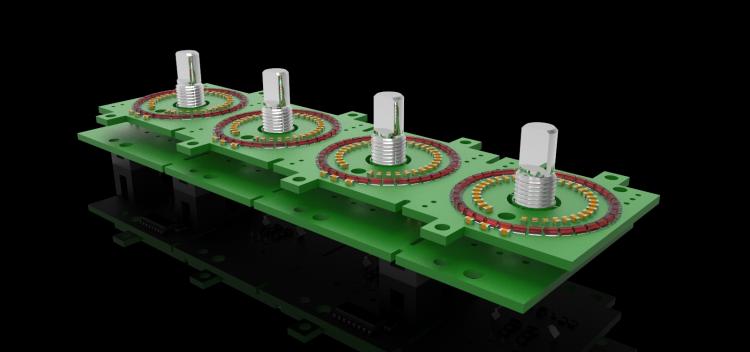-
Posts
55 -
Joined
-
Last visited
-
Days Won
2
Content Type
Profiles
Forums
Blogs
Gallery
Everything posted by weasel
-
yeah so while i was plugging some peripheral breadboard connections in and out earlier today, the moment it apparently died i was just playing on the keyboard and the encoders... the connected OLED screen went black first, then i noticed all 3 LEDs on the disco board blinking at around 2-3Hz. I tried reseting and a cold restart with no change, back to blinking. started disconnecting all IDC cable that were connected, same behaviour. next i unplugged the power line of one of the ws2812 chains which somehow still was connected to the ST board (gnd or data) and the blinking frequency change dot about 1Hz. 10-20 seconds, one or two resets later it was all black and never came back since... any idea what went wrong here so i can avoid doing the same with the next one? i think i was turning an encoder when it happened first, and there might have been a short somehwere on the kinda wonnky prototype setup i run?
-

LRE 4x1 breakable RGB LED-Ring/Rotary-Encoder PCB bulk order
weasel replied to weasel's topic in Bulk Orders
Alright, everybobdy stop whatever you are doing right now and gather to see what granddaddy Klose blessed us with: a little tease of the all new extended and improved WS2812 midibox driver: Gaze at currently 432 WS2812 controlled by a single J4 serial pin! -

LRE 4x1 breakable RGB LED-Ring/Rotary-Encoder PCB bulk order
weasel replied to weasel's topic in Bulk Orders
Ok guys, was away for a bit on family duties, here’s the final update before I put in the order within the next 2 days! I had @FantomXR change the LED Ring design to 32 instead of the prototypes 36 LEDs. That’s what I originally had planned too, for three reasons: 1. easier mathematical mapping of n^2 values 2. Better usage for rhythmic/timing use, ie. a 32 step circular sequencer (think Euclidean Circles module) 3. More space between the LEDs for possible masking solutions. The diameter of the ring will remain the same at 33mm. At the classic 80% perimeter encoder use (as shown in the demo videos with the bottom 5 LEDs blacked out), you will now have a 27 LED resolution instead of 31 on the prototype. The LED cross bleed which I was worried about for a while should be no issue with this updated version. Even without any masking or light pipes it is not that bad as you can see on all the demo videos. With the new LED distance it is quite easy to mill or print a little plastic masking ring if you want. And simple light pipes, even just hand cut from optical fibre, improve the quality a lot too. I will post pictures and videos of my results soon, but probably not in time before the order. Added SMD solder point for an optional power supply capacitor at the power supply pins of each LED board. Using WS2812C 2020 LEDs for much lower power consumption than the B variant. Added some extra pinouts on the encoder board for more efficient use of the 74HC165: on the prototype each 165 was filled with the 6 pins of two switchable encoders, wasting the 2 remaining pins. Now all 8 pins of the 165 have unique TH-solder points so empty pins of the 165 can easily be used for additional buttons. Eg. You can now connect 2 switch-less encoders and 4 pushbuttons to the same 165, or 1 switchable encoder and 5 pushbuttons, twice that per encoder PCB. Added a TH-solder point for the 165 Clock Enable pins so the boards can be used with bitbanging protocols instead of SPI only. Unfortunately due to some family emergencies over the last weeks I was not able to finalize the design in time for the afore mentioned manufacturer discount. I still managed to get a decent offer, and so far group orders including my own demand are at around 160 sets. That gives the following prices: Net manufacturing cost per fully assembled PCB set: 19-21 EUR (depending on the final numbers) Import taxes (VAT of 19% for EU, tbd for US and other countries) around 4 EUR per set Individual shipping to you (tbc, but probably 5-10 EUR per shipment, depending on destination country what shipping insurance etc you want) That equals to a roughly estimated overall sum of 30 EUR for 1 set, 50 EUR for 2 sets, 90 EUR for 4 sets, 170 EUR for 8 sets. plus/minus 5% i guess. This isn’t cheap but I am 100% sure it still is really good value for what you get. It's around the same price you pay for one single ALPS rotary encoder with a single color LED ring. The price is for a set of two PCBs, one with 4 RGB LED rings, and one for 4 rotary encoders. All SMD parts and the assembly is included, the actual rotary encoders and any through-hole solder pins are not included. Might be able to supply standard Bourns PEC11L if needed. I personally pay about 7 EUR more than this for every set, in my personal development/protoyping costs. So if you feel generous and support the cause, the net price per board would be 25-26 instead of 19-21 if I distributed the dev costs equally. Order will be put in this week, production and shipping will take approx 2-3 weeks, and then another week for testing and further shipping on my side. Expect it in your mailbox end of july. Also I am talking to a very popular US based modular DIY supplier who will eventually stock some boards in his webshop. Will confirm asap, pricing tbd. And a summation of what I think is important information: This is a non commercial group buy of a pcb board. You buy the pcb board with all the SMD parts and assembly and nothing more. Of course I will take full personal responsibility in case something is fundamentally wrong or not working at all with the final product, based on a design mistake on my end. But other than that that’s all you get. No official support, no guarantees etc etc. That being said: I designed these for the MIDIbox platform originally and I also successfully tested and use them on Arduino boards and the Axoloti platform. They work perfectly. I will write basic functions and objects for all these platforms over the course of the next weeks and of course I will share all these with everybody. Also basic general control for ws2812 LEDs and 74HC165 rotary encoders is readily available for all platforms already. I’ll also throw together some basic quick start guides and assist with connection set-up problems, but I expect anybody getting in on this order to be able to set up their own serial communication on the right pins of their respective controller boards. Expect a hardware protocol limit of around 500 LEDs (3-4 4xLED boards) per serial line if you want to maintain a 60Hz refresh rate, as with any WS2812 application. Also the obviously the more 74HC165 you chain in series, the higher the latency will get. Both those programming libraries and the PCB design will be open sourced at some point. I don’t know when because I don’t want to do a half assed job on that and proper cleaning/optimizing and documentation might take a while. You will have to buy and solder your own rotary encoders. The boards are designed for and tested with the Bourns PEC11 and PEC16 range, I personally recommend PEC11L low profile encoders. The optional LED board SMD power input cap would have to be self supplied and hand soldered too but in most cases will not be necessary. So yeah that’s about it. If I didn’t scare you away by now, please RSVP as soon as possible. Either here via a private message or via email at rgbledring at gmail dot com, then we can exchange personals and discuss details. Also, in extremely exciting midibox news, a very special someone decided to start redesigning and expanding the WS2812 drivers. I will post updates as soon as we did some testing! -

LRE 4x1 breakable RGB LED-Ring/Rotary-Encoder PCB bulk order
weasel replied to weasel's topic in Bulk Orders
thank you so much, great advice! will get back later with results and thoughts! i'll order some troLED and get that fablab CNC going.. what do you think about the idea of just casting 0.84mm (LED height) of black resin or epoxy directly on the LED PCB, to surround the LEDs and thereby cover the sides, only leaving the top side open? either cast a thin liquid expoy or use something more gluey pasty and press it in/scrape off the top? i think the direct 90 degree side-to-side bleed between two neighbouring LEDs is my biggest culprit right now. edit: what router bits are you using? dremel/proxxon stuff? i assume you run through a lot of them, breaking? any recommended brand? -

LRE 4x1 breakable RGB LED-Ring/Rotary-Encoder PCB bulk order
weasel replied to weasel's topic in Bulk Orders
@Antichambre man that finished frontplate looks so incredibly amazing, insane job, congratulations again. what kind of router & bit did you use to mill the PMMA? not sure the CNC at my fablab is fine enough.. not only are my measurements a good bit smaller but also i start realizing the laser cutter with its convexed cutting edge is not really precise enough for light channels like that.. so the biggest issues of translating your approach would be the holes in the black MASK layer, or rather the walls between the holes. @FantomXR i did some quick maffs, if we go 36>32 that will give me an additional width of the radial gap between each of the LEDs of 0.2-0.3mm, at the smallest most inwards point. so almost double what it is right now, i would have around 0.5mm at the smallest point which should make the masking much easier. might still have to CNC and not laser cut. oh and trotec FTW, they were the easiest and nicest to deal with too. innograv almost didn't take my business lol. oh bruno if there is any chance you have some pictures of the MASK and WINDOW layer combined with the LEDs stuck through? or any more close up/side shots of the all-layer frontplate. that would be formidable oui oui. i ordered a bunch of different epoxy/milliput/sealer combinations too though and still wanna try just casting/filling the whole 0.84mm height around each LED. anybbody ever tried filling frontplate LED holes with epoxy or similar? EDIT: epiphany? what if i make a silicone negative of the fully assembled LED ring board, and then cast a theoretically perfect resin/epoxy mask from it? where do i learn about this haha. oh wait. i need a double negative casting shape. prolly all too much effort, i wanna make music not get into plastic manufacturing. also i will try some ready made light pipes - anyboby has a good source for those? mouser etc start at 50ct/piece for the 1mm ones, that would be 70EUR per 4x1 board lol. have some regular 1mm and 1.5mm optical fibre cable coming too but i assume that will be hard to cut to size precisely and make it perfectly flush with the frontplate? made some more lasercut cardboard masks last night, i think they came out better but probably not perfect. will test and report tonight. @TK. thanks, yeah i somehow was sure you would consider expanding the code after we approached this barrier... i know you'd do that "im schlaf" basically. but here's my opinion: other than RGB LED rings probably nobody would ever want to connect that amount of WS2812 to a midibox. i personally would LOVE to be able to avoid the extra arduino, i just went there lacking an easier alternative, i didn't prefer it at all! so of course, midibox support would be great, but if i understood it correctly you want to reduce the amount of work you personally put in on midibox, and given that, i am also not sure if it is worth your time to work on this this driver. maybe you should save your much appreciated midibox time for someones more urgent problems? would love to hear other people's opinion on this. cause on the other hand the WS2812 is such a stable in the DIY world by now. i'd very happily send you whatever display/mapping/ring-style code i have if you end up doing something. for you to laugh at, delete and redo properly. EDIT 2 i can't stop staring at your frontplate bruno haha so beautiful you need to sit your ass down and finish these. -

LRE 4x1 breakable RGB LED-Ring/Rotary-Encoder PCB bulk order
weasel replied to weasel's topic in Bulk Orders
haha man i keep coming back to that solution but i wanna try everything first to avoid it. i know i wanted 32 LEDs to start out with, but now that i got used to the higher resolution, i'd miss it. if i keep the same 5 bottom LEDs covered which i have to, it would only be left with a real life resolution of 26-27 LEDs... shoulda went with 0603 APAs maybe lol seriously though, we might have to walk the 32 LED way.. give me a couple more days. -

LRE 4x1 breakable RGB LED-Ring/Rotary-Encoder PCB bulk order
weasel replied to weasel's topic in Bulk Orders
Hey @Antichambre, thanks a lot, good call on the forum post! I feel like this doesn't belong in the bulk order thread though so lmk if you want me to move this to a new thread before you or anyobdy else answers... So i am currently investigating frontplate options and i realized some small issues with these 2020 LEDs: they are in a completely transparent housing, as opposed to the white housing with a top lense of the 5050 2812s. So naturally i get quite some cross bleed between the neighbouring LEDs, at highest brightness setting even up to 2-3 LEDs far. In real life it is not nearly as noticeable as on those videos i posted but i am still trying to optimize it. Then of course i remembered your own glorious LED rings and the transparent inlays you sent me a picture of once. Would you mind in explaining in detail a bit more how you did them and if you think they are viable for my situation? Following are some sketches of what i have so far and some ideas. The "light channel" drill holes got pretty long, 3.5-5mm over all, but that actually makes frontplate assembly super convenient and also should reduce the cross bleeding by creating a more narrow viewing angle. any input is welcome! 1. This is a description of what you see on the videos, what i started out with. just a 3mm mdf with 1.25mm holes for each LED, and another 1.6mm acrylic layer on top, same holes. they align nicely and sit right on top of the middle of the LEDs. The thin arrows show where i think most of the crossbleed comes from. the whole housing of the LED is transparent resin so the 3 tiny R G B LEDs all emit light in any direction of almost half a sphere. 2. So the first thing i tried to improve it was to cut a negative mask out of MDF to enclose each LED, leaving room for the condensators and solder points. its black coated MDF and obviously the details are a good bit too much for the laser. but i am sure i could still improve on these first tries. it did improve the bleed a little but not to the extend i hoped for. 3. i tried the same technique but with black cardboard instead of the MDF, and the little bridges betwees the LEDs came out even better. 4. the next thing i want to try is different materials. i did a first cut of the same negative mask as above in solid acrylic but didn't get to test it yet. i have to play with the lasercutting margins and measures to make the fit as good as possible, eg. i left space for the extra solder points but not for the blobs of solder around the LED connectors. but right now i am more interested in alternative methods. what about using milliput or some other thick epoxy stuff, press it on the LED pcb so the top stays somewhat clear, and carve off remainders after hardening? something like this: (note: most likely my final front-frontplate will be aluminum..) anybody has experience with using milliput/expoy like this? another thing to try is the resin-based 3d printer in my local fablab which might be detailed enough to get a better mask going. and yet one more idea is to get some thick lightproof acrylic paint and a tiny brush and try to paint the sides of the LEDs, or even spray paint it with circular masking tape on the top? also i am not sure about how to fill the light channels in the frontplate, what you, @Antichambre did so beautifully with those inlays. i was also gonna try just fill them with epoxy and razer off any residue on the outside? or maybe get some 1.25/1.5 mm optical fibre, and stuff each LED hole with a 3-5mm piece that ends directly on the LED enclosure? might also help reduce bleeding. Here are some more pics of @FantomXR's beautiful prototype SMD assembly job, you can see the shape of the LEDs really good. in before questions: shot on iphone with a 10$ hama macro lens i just bought on impulse at the local electronics megastore. keep in mind these LEDs you see are 2x2.2mm small... and to lighten things up here's another video, this time i added some shift functions. -

LRE 4x1 breakable RGB LED-Ring/Rotary-Encoder PCB bulk order
weasel replied to weasel's topic in Bulk Orders
of course, first things first!! the manufacturer seems to currently have a discount on the assembly parts of the job, so prices will go down a bit! will update asap! here's some basic music functionality tests: -

LRE 4x1 breakable RGB LED-Ring/Rotary-Encoder PCB bulk order
weasel replied to weasel's topic in Bulk Orders
here's a cute little video with a prototyping frontplate. bottom 5 LEDs are blacked out intentionally for classic "fake poti" use. this right now is controlled via arduino, not midibox, since there were more convenient demo routines available. frontplate is 3mm mdf, sitting more or less directly on the ws2812. top row has slightly bigger holes than bottom row. ws2812 running at 25% brightness.... -

New eurorack modules from midiphy - preview
weasel commented on Hawkeye's gallery image in Members Gallery
-

New eurorack modules from midiphy - preview
weasel commented on Hawkeye's gallery image in Members Gallery
-

LRE 4x1 breakable RGB LED-Ring/Rotary-Encoder PCB bulk order
weasel replied to weasel's topic in Bulk Orders
Great work @FantomXR that picture looks absolutely terrific. we will evaluate the design for a couple more days and run some more tests and then finalize the bulk order with updated prices, anybody interested can PM me now. edit: fwiw, alternative method of driving ws2812 on the F7DISCO: https://stm32f4-discovery.net/2018/06/tutorial-control-ws2812b-leds-stm32/ -

LRE 4x1 breakable RGB LED-Ring/Rotary-Encoder PCB bulk order
weasel replied to weasel's topic in Bulk Orders
Wow this is amazing news, the OG just blessed us with a firmware update! I am pretty sure @FantomXR will get them running just fine now! Thanks so much @TK. this will help alot and we should get at least 2-4 LED-Ring-Boards going. I'll send you some for reference once i have the production run! I read through the mios32 ws2812 documentation and realized you need to use 48bytes per LED for the PWM DMA solution. I do understand the motivation behind this, saving CPU power, but is there a somewhat easy way to go back to other methods as described in the uC.net article you linked? Thinking of the "average" midibox tasks, i doubt it pushes an STM32f4 to it's CPU limits? Guess using the flash memory would wear it out too fast? I would love to implement it myself but that's way beyond my knowledge and time constraints, and at the same time i assume there is little need for other people to go beyong 300-400 LEDs. But how do other ie. arduino ws2812 drivers get away with just using 3 bytes per LED, on a much slower CPU? Since for 40-50 encoders i need to adress between 1500 and 1800 LED - 72kb at 48bytes, ca 5kb at classic adressing - i guess i might have to just add a little arduino or similar MCU to control the ws2812. even the smallest UNO can handle 500 ws2812 at 60Hz, and the Due with its 3-4 serial lines should be able to run all 50 encoder-LEDs i need. -

[SOLVED] SSD1306 again. Help an idiot find his mistake please.
weasel replied to weasel's topic in MIDIbox NG
yeah since i'm coming form woodworking - maybe the OLED had to adjust to room temperature first -

[SOLVED] SSD1306 again. Help an idiot find his mistake please.
weasel replied to weasel's topic in MIDIbox NG
well after a million tests and power cycles yesterday i just turned on my main system power supply this morning and got this so consider this case closed. -
These look very interesting indeed. Not as obviously/conveniently freely programmable. I am currently building a synth on the axoloti platform. While rough around the edges the patching software for it is a really great balance between simple modular patching and hardcore coding. But the hardware is kind of outdated (same STM32F4) and the community rather slow these days. There are currently notions to develope upgraded hardware on an ARM m7 or other newer platform though. http://axoloti.com/ sorry i just kind of crashed into this thread from a search result, not sure if this might have been discussed before or even is way off topic. oops.
-
I wired up my 7pin SPI 1306 according to this diagram using 1k res and 10u cap. but i'm failing to get anything out of the screen. trying to just print text through the console lcd command, or the hello world program or even the NG init message. i did set the correct LCD type in the bootloader: there's this other old thread where someone had to connect the OLEDs reset pin to some other core connectors GPIO pin iirc? is that really the way to go, no convenient simple conncetion available? i tried manually setting the reset pin to 0/3.3 via the testlcdpin command, no success. while manual, that should do the same trick as the GPIO pin reset above, right? edit: i realized the J15 reset pin is connected to the DC pin of the OLED? so no manual reset this way? i tried doing some measurements. core board soldering seems ok. power/ground voltages are also where i think they're supposed to be everywhere. is there a page or list with debugging measurement points on the STM32F4 core board? DINOUT and AINSER 64 work for what its worth. more pictures of my "circuit" i realized in the above picture the SDA cable was in p4 instead of p6, that was not the issue though. OLED supposed to work on 2.8-5.5v, i tried both 3.3 and 5v jumper settings. yeah i know my soldering is "sub par" GND and VCC from both j15 and the OLED going to the power strip on the breadboard, and the blue wire to the reset pin.
-

LRE 4x1 breakable RGB LED-Ring/Rotary-Encoder PCB bulk order
weasel replied to weasel's topic in Bulk Orders
yeah so at first i just randomly tried multiplying the result by two and then it was right and i thought "well that's one of these programming things where you just hack a '+1' and then it works" and never find out why. but then i found this line // timers clocked at CPU/2 clock, WS2812 protocol requires 800 kHz (1.25 uS period) CPU/2 clock so it actually adds up. or rather divides up. -

LRE 4x1 breakable RGB LED-Ring/Rotary-Encoder PCB bulk order
weasel replied to weasel's topic in Bulk Orders
i might be too high or otherwise intelectually challenged for this, but fwiw your maths seem right - it is 105 CPU cycles which at 168 MHz amount to 1.25uS. so at a 2 MHz clock rate it should be (168000000 / 2) / 2000000 = 42 CPU cycles = 0.5 uS which also seems to roughly correlate to the timings given in the datasheet which says 580nS-1uS edit: ignore the last 3 lines, i am confused about which clock rate we actually need to get to, all data sheets say 800 KHz. so if it's not 2 MHz, do your own maths everybody :) but hey i did notice that 105 is CPU cycles and that it indeed is 1.25uS. That gotta be worth something, right? -

LRE 4x1 breakable RGB LED-Ring/Rotary-Encoder PCB bulk order
weasel replied to weasel's topic in Bulk Orders
prototypes arrived today! (just posting to try and create a little pressure on @FantomXR for the proto-assembly ) -
beautiful, funny enough i saw these yesterday, saying 1306 compatible and ordered some...
-

LRE 4x1 breakable RGB LED-Ring/Rotary-Encoder PCB bulk order
weasel replied to weasel's topic in Bulk Orders
As another estimate, from what i gathered the update rate of the WS2812 limits one chain to about 500 LEDs, and at that keeps a refresh rate of 60fps for the whole chain which should be more than enough for musical controller values. So as already mentioned in our DMs, worst case we'll have to use 2-3 serial pins. So while there might be limitations and downsides to our approach i am pretty confident it will still do just what i want it to do :) -

LRE 4x1 breakable RGB LED-Ring/Rotary-Encoder PCB bulk order
weasel replied to weasel's topic in Bulk Orders
Yeah as @latigid on said WS2812c is only a couple cents in the quantities we're buying. about 50% of the quoted prices goes into the assembly. @FantomXR thought about assembling himself with his reflow equipment but soon realized it will be way too many parts that need almost perfect precision. Regarding encoders, the cheapest higher resolution ones i ever saw started at 30-40 euro. i'll personally most likely use regular 24 ppr ones with no detent which is perfectly fine for me. i think based on the layout for these boards which we'll publish once finished, it should be easy for someone to remodel the upper LED layer to make a cheaper single colour version. or maybe there randomly are cheaper single colour chainable LEDs that fit the same footprint? -

LRE 4x1 breakable RGB LED-Ring/Rotary-Encoder PCB bulk order
weasel replied to weasel's topic in Bulk Orders
RGB LEDs allow to code a lot more information on a single ring - i can for example have several shift- or mapping applications on the same encoder with the changing color immediately and obvisouly indicating the function. you could also do classic VU style green-yellow-red structures indicating the "hotness" of a value, giving much easier and faster visual feedback over the current value. i think @latigid on did something similar with encoders with a transparent knob. all the ready built WS-/or other RGB-LED rings have far to low resolution, you would get about 8 LEDs on the same diameter. as far as i know there are no hi-res (ie 24+) LED rings on a 2020 base, allowing for usable diameters. edit.: just did some quick maths - 4 neopixel rings also actually aren't really cheaper than getting these perfect sized hi res PCBs fully assembled. of course there are cheaper ways to get a LED ring but in this case i don't want to DIY to be cheaper, but rather better than commercially or previously available solutions. -
Hey there, As announced in the other thread I had the need for a 4x1 LED-ring/rotary encoder board. The incredibly talented @FantomXR helped me realize the design and together we came up with some pretty cool improvements on @Fairlightiii's (RIP) classic: - two layer sandwich PCB to get the SMD LEDs on surface level - encoder-slots compatible with both 11mm and 16mm encoders, with or without switch - two 74HC165 per encoder-board for direct connection to the core board, convenient midibox 10-pin IDC connectors - breakable design allowing to easily get 3x1, 2x1, 1x1 board configurations, partially leaving both broken parts usable/connectable/chainable. - Full ring of 36 WS2812c RGB LEDs in 2020 size, diameter of 27mm. The full ring allows for vertical or horizontal application as opposed to the classic 80% perimeter LED ring. 36 LEDs make up for the lost resolution. - additional power supply inlets for the hungry LED rings - distance between encoders is 33mm in the prototype, might change to 35mm for production, allowing for bigger knobs. Not a fan of the current micro-encoders. - option for whoever needs it to design a compatible OLED-overlay-board to use instead of the LED-Ring board and thereby achieve something similar to @Antichambre's great OLRE board. The design is not fully tested yet and we might make some adjustments but I wanted to put this bulk order up already so everybody gets a chance to see it before we order. Which will be as soon as the prototype has proven itself, hopefully in about 2-3 weeks. There is a number of questions to be addressed when the prototype arrived, ie maximum number of WS2812 on a single core board, overall power consumption etc. Obvisouly i am very happy about any ideas or constructive criticism regarding the design. Here is a price overview that we calculated from an offer we got on a slightly older design, so it might vary depending on the total order amount and possible design changes, plus a tiny shipping&handling fee. I will personally order around 50 each so would make it to the middle price bracket probably. Encoder board: 50pc --> 10€ / pc. 100pc --> 7€ / pc. 200pc --> 6€ / pc. LED-Ring board 50pc => 28€ / pc. 100pc => 23€ / pc. 200pc. => 20€ / pc. Yes these are pretty expensive compared to your usual diy pcb board, but we ruled out any self-assembly pretty early, given the amount of parts and also the sheer number of boards I personally need. So we will order these boards with all SMD parts fully assembled, if anybody is interested we could obviously also get some plain pcb boards made on the side. So yeah please send me a DM or post in this thread if you are interested in ordering some of these. Here are some nice renderings courtesy of the genius @FantomXR who might also chime in with schematics or if anybody has more specific technical questions.


